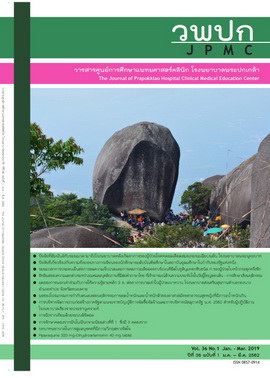Management of Official Construction Work under The Government Procurement Act of 2017 for Chiangrai Prachanukhroh Hospital Officers
Main Article Content
Abstract
Background: This research was conducted to produce a management model for the administration and management of official construction work as per the Government Procurement Act. Due to the difficulties and complexity of procurement work, responsible officers must possess good knowledge, understanding and skills pertaining to the working procedures for precision, rapidity and effectiveness.
Objectives: To study the operation of officers for construction procurement according to the Government Procurement Act and their satisfaction towards the manual for construction management.
Materials and method: The descriptive research method was used to compile relevant knowledge for the production of the construction management model, which was tried out by the officers. The sample group comprised 115 relevant officers. The research instrument used was the questionnaire. Data analysis was based on the statistics showing frequency, percentages, standard deviations and t-test scores.
Results: The study conducted with 115 construction management officers reveals the following problems: The Act, which was new to the officers, caused risks and errors of work (92.2%). A lot of difficulties were caused by the great number of documents involved (87.3%). No clarification had been made in terms of consultancy for the procurement problems (86.9%). There were many appointed committees resulting in complicated implementation steps (86.9%). However, these problems were reduced after the manual was made and used (to 44.4%, 54.7%, 36.5%, and 31.3% respectively). The effectiveness of implementation following the Act was at a moderate level before the manual was used and increased significantly after its use (p-value). Officers now have knowledge and understanding (t=17.3, p < 0.001), are able to manage the work (t = 24.8, p < 0.001), can follow all of the steps required (t =25.6, p < 0.001), and the operations are quick and completed in time (t =21.9, p < 0.001). The satisfaction towards the manual was found at a high degree, especially the overall attitudes towards the model (x̄ = 3.9, SD = 0.6) and its practicality (x̄ = 3.9, SD = 0.7).
Conclusion: The manual for management of construction work according to the Government Procurement Act of 2017 can be used effectively, and will lessen difficulties and tardiness from lack of understanding of officers in charge.
Article Details
References
The Comptroller General's Department. Government procurement and supplies management act B.E. 2560. Bangkok : Cabinet and Royal Gazette Publishing Office; 2017.
The Comptroller General's Department.Treasury regulations of government procurement and supplies management act B.E. 2560. Bangkok: Cabinet and Royal Gazette Publishing Office.; 2560.
ChainadK ,Cain PM, Khotchakhot P. Guidelines for solving problems in purchase and employ by inquiring prices of sub-district Municipalities : a case study of local administrative organizations in Mueang ,Kalasin. Journal ofPolitical Science and Law Kalasin Rajabhat University 2014;3(1) :149-68.
Chukeaw C. Independent study title barriers to the process of procurement of the ministry of Ranong. Proceedings of the 8 th Academic Meeting . National and International Research Presentation, 2017 March 16; Bankok, SunandhaRajabhat University ; 2017. p. 648-59.
Srisa-ar B. Introduction to research. 9thed. Bangkok : S.uviriyasan; 2013.
SangjanR.This expedition is new procurement guidelines of government procurement and supplies management act B.E. 2560. Paper presented at: The Internal Audit Khonkaen University; 2017 June 26; Khonkaen.
State Audit Office of the Kingdom of Thailand. The Report on the work of the office of the State Audit Office B.E. 2559.Bangkok :State Audit Office of the Kingdom of Thailand; 2560.
Vongprasongchai U, Wongwattana S, Jitgaroon P. Problems and development guidelines on material administration for material officials in Naresuan University. Journal of Graduate School, PibulsongkramRajabhat University;2013; 7(1):139-48.

